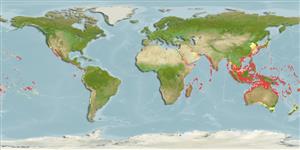Common names from other countries
Environment: milieu / climate zone / depth range / distribution range
Ecologia
; intervalo de profundidade 2 - 71 m (Ref. 101222). Tropical
Indo-Pacific.
Length at first maturity / Tamanho / Peso / Idade
Maturity: Lm ? range ? - ? cm Max length : 50.0 cm TL macho/indeterminado; (Ref. 822); common length : 12.0 cm BASL macho/indeterminado; (Ref. 349); Peso máx. publicado: 500.00 g (Ref. 2594)
Common among seaweeds and grass flats in shallow water environments, especially in sheltered bays and lagoons (Ref. 349). Found during the day under rocks and at night crawling around reef flats and seagrass beds (Ref. 844). Inhabits eel grass beds, reef flats, or tidal swimming pools (Ref. 866). Nocturnal (Ref. 822).
Life cycle and mating behavior
Maturidade | Reprodução | Desova | Ovos | Fecundidade | Larvas
Members of the order Anaspidea are mostly simultaneous hermaphrodites.
Poutiers, J.M. 1998. (Ref. 349)
Status na Lista Vermelha da IUCN (Ref. 130435)
Status no CITES (Ref. 108899)
Not Evaluated
Not Evaluated
Perigo para os humanos
Harmless
Uso pelos humanos
| FishSource |
Ferramentas
Fontes da internet
Estimates based on models
Preferred temperature
(Ref.
115969): 22.6 - 29.1, mean 28 (based on 1616 cells).
Resiliência
Elevada, tempo mínimo de duplicação da população menor que 15 meses (K=0.8-1).
Vulnerabilidade
Moderate vulnerability (40 of 100).
Categoria de preço
Unknown.
